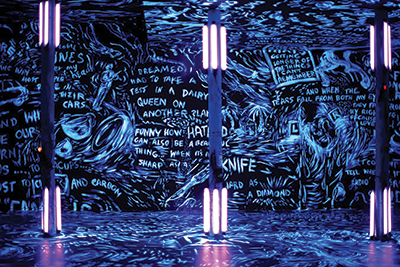Virtual Reality Experience
MASS MoCA has virtual reality (VR) experiences from Laurie Anderson, which you can view through 2020. She has developed projects there in the past and was an artist-in-residence. Anderson is a poet, filmmaker, vocalist, and multimedia artist, and the VR experiences of Chalkroom and Aloft showcased that. For both you would sit in a swiveling chair, place a VR headset with earphones over your head, and then were transported to another place and time that was like a curious dream of hers that you had entered.
Chalkroom is a massive labyrinth of black walls marked with chalk and glowing portals that you can fly through with a push of your arms. Aloft begins with you sitting in an empty plane that gradually comes apart around you until you are floating in the air, using your virtual hands to grasp at objects swirling around you, to listen to Anderson’s hypnotic anecdotes. When I experienced the latter, I grasped onto the seat because my stomach dropped at the illusion of being up high. In the former, I was giddy flying through and exploring the chalkroom. It was a strange coincidence that I had been seriously considering the importance of VR technology in museums just a month prior, and then got to experience it firsthand.
VR technology allows the audience to be emerged in the experience of a work of art, or it can act as a tour through a gallery. Curators, artists, and educators alike can utilize this technology for a new perspective on content. It connects to younger audiences that struggle to engage with static exhibits. VR can engage your hearing, movements, thinking, and visual perception. Though VR can draw people to museums, VR also means that people with impaired mobility or trouble accessing museums due to its location, cost, or social atmosphere can access great works of art and history from a remote location.
Money and timing are important factors. VR headsets can range from $20 to $1000 depending on whether you want headphones, hand controls, hand sensors, and a comfortable head clasp. By timing, I mean that if a museum could afford the technology, there would certainly be a limit on how much they could afford, so there may be two headsets that people must take turns to use, like at the Anderson installations that had six altogether and people had to schedule an appointment to have the experience. Despite this, VR technology can encourage new and returning visitors to offset the cost.
Hopefully, museums across the world will engage with this more immersive version of VR technology so that everyone can experience the richness of many cultures from close to home.

